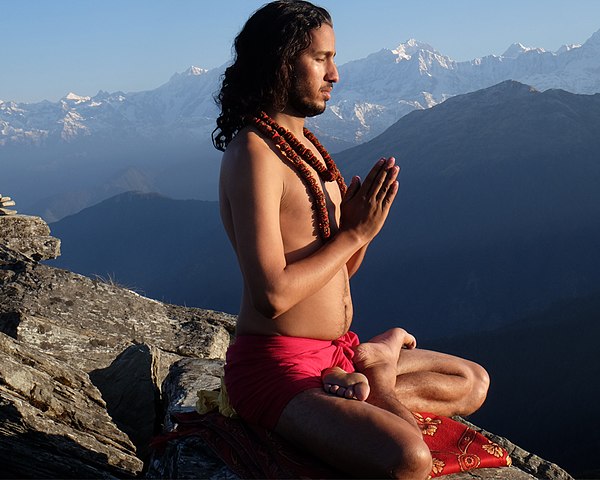सर्वे भवन्तु सुखिनः Sarve Bhavantu Sukhinah-4
An exclusive series on Universal Natural Health by Amritavarshini
(Continued from the previous post)
In that remote village of South India a long time ago, lived the venerable Elder of over a 100 years. Simply known as Thatha, he was a repository of ancient folk wisdom he had learnt from his forefathers, and had a panacea for every physical and mental ill that the villagers consulted him about. He gave them simple remedies and solutions for their problems. Among the many things he had learnt was that one should not walk or sleep under the tamarind tree at night. In order to keep the villagers from going into the tamarind grove at night, he told them that there were ketta kaatru (noxious gases, and also another name for ghosts in Tamil) there. His word was accepted by everyone, except a group of skeptical youth, who thought that he was superstitious.
So, one night, the friends decided to go to the grove and sleep there, to challenge the advice of Thatha. They lay under a big tamarind tree, telling jokes, laughing and chatting about ghosts and spirits. Hardly had they slept, exhausted, than they awoke one by one, in cold sweat and unable to breathe. The terrified boys were convinced that they had been ‘caught’ by the ghost! Leaving their mats and pillows, they somehow managed to run back to the village, screaming their heads off.
They woke up with severe body ache and palpitations and lost no time to seek out the Elder. When they told him that something had indeed ‘caught’ them at night, he merely smiled and gave them a simple prescription. They were to walk in the path with tamarind trees during day and sleep under a big neem tree at night, for the next 40 days.
‘So you met the ghost!’ Thatha chuckled. The boys looked suitably chastised. He then gave them a simple prescription of walking on a road lined with tamarind trees during the day and sleeping under a big neem tree at night, for 40 days.
They were afraid of going anywhere near a tamarind tree, even during the day, leave alone sleeping under any tree after their previous night’s scare. Finally Thatha accompanied them. Surprisingly, their aches and pains vanished and palpitations were gone, when they woke the next morning. Naturally they were curious to know how they had been cured and wanted to know why they should continue the treatment for 40 days.
Thatha then explained that the experience after inhaling toxic air through their mouth, while talking and sleeping after that might scare them again as it had the first time, especially if they were alone. The 40 days period would ward that off. He told them about certain trees including the tamarind tree, and a tree with similar fruits/pods like tamarind that grows extensively around the country, variously called Kodukkapuli/Vilayati imli/Madras thorn (Botanical name: Pithecellobium dulce), that give out prāña vāyu like the other trees during the day, but breathe out all the ketta kaatru (noxious gases) at night. Whereas, the neem tree releases prāña vāyu all through the day and night, which is why they had felt refreshed in the morning. They had felt choked because they had chatted non-stop before they slept and then inhaled so much of carbon-di-oxide in their sleep.
Thatha hastened to add that even when they breathed out all the noxious gases at night, the tamarind tree and others of its kind were just readying themselves to give out prāña vāyu the next morning to continue helping humans and animals. In a way, this explains how they help when they can but are helpless when they cannot. By this, the plant kingdom teaches us a lesson about helping fellow beings whenever we can without shirking the responsibility of doing so.
Why only 40 days, and why not more or less number of days? This has a very spiritual reason in addition to the physical reason. It would be pertinent to speak about the term vratam, here.
Sanyāsis and mathādiśas of ascetic orders observe Chaturmāsya vratam, staring from the month of Jyēśtha (ज्येष्ठ). During this period, they go to secluded places for four months, where there is no disturbance or sensory distraction in the form of visitors. They live on a frugal diet of fruits and uncooked food, eating just once a day. This is a sātvik way of observing vratam giving the due rest to the panćabhūtas in the body and panćēndriyas to the mind. Our elders have stipulated this period of vratam during the monsoons, when our body and mind need the deserved rest.
For the bodily organs governed by the panćabhūtas too, any course of treatment is a vratam. For example, in the above instance, one organ in the body—the respiratory organs, say–may accept the new habit of walking through a grove of tamarind trees in the morning and through the groves of neem trees in the evening. But other organs – say, digestive organs–may not accept this ritual right away. It normally takes 40 days for all organs to function in sync, to achieve complete cure as per the organ clock theory. As we all know, practice makes one perfect. For instance, many months of practice is necessary for an athlete to enter a competition. So also, the period of time for all organs to get accustomed to a particular pattern of behaviour in respect to health is 40 days – added with a monotonous pattern of diet.
Here, I would like to point out that the panćabhūtas have a very close relationship with panćēndriyas (five sensory organs). These, viz., śabdam, ruchi, gandham, drşti, and sparśam (sound, taste, smell, sight and touch), create powerful hurdles in our efforts to achieve sādhanā, vratam and dhyānam. Though our body sits still at one place, our mind wanders all over the globe; our ears may be sensitive the slightest distraction; our hand instantly rises to scratch the skin if a mosquito bites us; our eyes will open to see what caused the specific smell, and so on.
No wonder Adi Shankaracharya referred to the panćēndriyas as wild animals. In the 43rd shloka of Śivānandalahari, he says:
मा गच्छ त्वमितस्ततो गिरिश भो मय्येव वासं कुरु
स्वामिन्नादिकिरात मामकमनः कान्तारसीमान्तरे
वर्तन्ते बहुशो मदजुषो मास्तर्य मोहादय
स्तान् हत्वा मृगयाविनोदरुचितालाभं च संप्राप्यसि II
Don’t go here and there, Oh God of the mountains,
And please my lord, always live in me.
For Oh primeval hunter, within the limits
Of the dreary forest of my mind,
Live many wild animals like envy, delusion and others,
And you can kill and do thine sport of hunting,
And enjoy there yourself.
That was the literal meaning of the verse. Here is another one that is closer to my heart.
It says: O! Śiva! You came to give Paśupathāstra to Arjuna. You are the first and foremost hunter. If you are fond of hunting, you need not go anywhere else. Come and stay in my hrdayam (heart) and hunt the most dangerous wild animals that dwell there, as you please, and give me your anugraha (grace).
If Śiva were to dwell in our hearts, His anugraha will be perfect and permanent, as he will hunt the índriyas and kill them or keep them under his control and prevent their wandering.
It is interesting to learn how the inter-connection of the panćēndriyas and their connection in turn, with the panćabhūtas, bind the jīvātmā with Paramātma – held by the prāña till we leave our mortal body – and then directly binding with Him when prāña link is severed.
Continued…….
A version of the post was first published in Jagrit Bharat on August 18, 2018. Published on The Cybernag with kind permission from the author Amritavarshini.
Please read the earlier posts in the series:
1.THE SCIENTIFIC WISDOM BEHIND ANCIENT INDIAN CUSTOMS
2.PANĆA MAHABHŪTAS AND THEIR ROLE IN WELLNESS
3. THE MOST IMPORTANT BHŪTA – VĀYU, OUR VERY LIFE
Images courtesy:
Meditating yogi: https://commons.wikimedia.org/
Adiyogi Shiva: https://www.templepurohit.com/









[…] 4. PANĆABHŪTA AND PANĆĒNDRIYĀ […]
LikeLike
[…] 4. PANĆABHŪTA AND PANĆĒNDRIYĀ […]
LikeLike
[…] the story of the boys who had run away from the tamarind tree, which I had written about in a earlier article. There too, it was their screams that helped them move, by eliminating the noxious air they had […]
LikeLike
[…] (Continued from the previous post) […]
LikeLike
Need to catch up on this valuable series. One of these days hope to find some time to go through them all. Thanks for bringing it here in this form.
LikeLike
Please do. You will find it very interesting and useful.
LikeLiked by 1 person